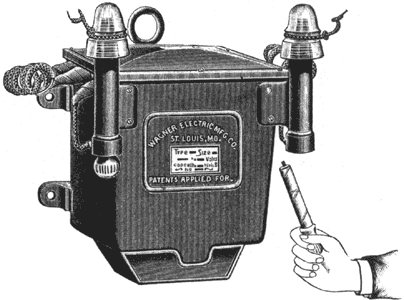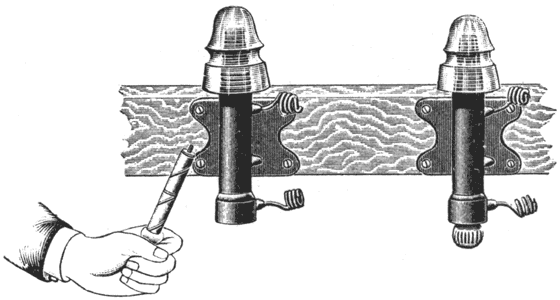[Trade Journal]
Publication: Electrical Industries
Chicago, IL, United States
vol. 6, no. 4, p. 107-108, col. 2,1
Wagner Transformers and Fuse Brackets.
Something quite new in the line of transformer attachments has recently been brought out by the Wagner Electric Mfg. Co., of St. Louis. It combines an insulated support for the line wires with a specially constructed fuse block. A fuse block should be so designed that it will not allow an arc to to be formed; the fuses should be separated so that one can be removed and replaced without disturbing the other and should also be so designed that a new fuse can be quickly inserted. These qualities and many others are found in the fuse block illustrated herewith.
 |
| Fig. 1. — Wagner Transformers and Fuse Brackets. |
In Fig. 1 is shown the devices attached to the well-known Wagner transformer. The advantages of the insulated support is evident to all who have hung transformers on pole or building. The same cut shows the fuse plug. These plugs, which are carried in separate cast iron cases, are removed by a few turns of the knob. There is no cover to be removed and no tools are required to replace a burned out fuse. The plugs and shell are made from pure lava, which has been found one of the most refractory substances for this purpose. Repeated tests with currents of high voltage have proven that an arc will not occur on these fuse plugs. The guaranty that accompanies them guarantees them up to five thousand volts.
 |
| Fig. 2. — Wagner Transformers and Fuse Brackets. |
The insulator bracket is a part of the design to make the transformer easy to put up. A large ring at the back, hooks for cross arms or wall and the support for the wires provides everything for the quick and secure installation of the transformer. In Fig. 2 is shown the fuse plugs and insulator attached to cross arm. They can thus be used when it is desirable to protect a branch running from the main into a building or to a lamp or group of lamps that may be in the street.
The transformer shown in this connection is known as type D. It is furnished with oil insulation and is wound for 1,000 or 2,000 volts. It is made of sizes from five to five hundred lights. For places where a transformer with dry insulation is preferred the type E is furnished, which is quite similar to type D.
